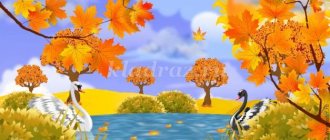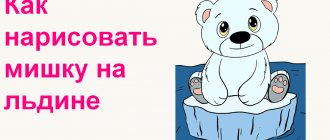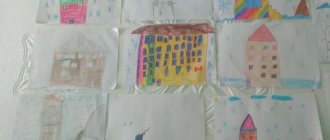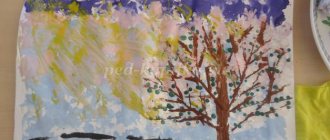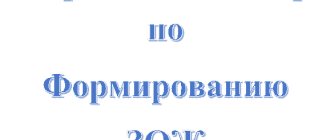Open lesson on communication in the middle group on the topic: “Pets”
Open lesson on communication in the middle group on the topic: “Pets”
Goals and objectives:
Educational:
1. Learn to use the instrumental case of nouns, practice agreeing words by case.
2.To consolidate and clarify children’s knowledge about domestic animals and their cubs;
3. Exercise children to answer the teacher’s questions with a complete answer.
4. Compiling a descriptive story of the animal according to the diagram.
Developmental:
1.Develop auditory and visual perception, fine motor skills;
2.Improve thought processes;
Educational:
1. Cultivate a love for pets;
2. Develop the ability to listen carefully, develop the cognitive process;
3.Develop communication skills.
Equipment: easel, pictures of domestic and wild animals, toys of wild and domestic animals, model of the “village” and “forest”, rubber massage balls, sound panel “pets”.
Progress of the lesson:
Children enter the group and greet the guests.
Organizing time.
Educator: I invite you on a journey into the animal world. This morning a white-sided magpie flew into my window and brought a letter from my grandparents on its tail. Let's read it! He takes the letter out of the envelope and reads: Hello, dear boys and girls. We had a problem - all the animals from our yard fled. Please help me find them. And to find our animals, you need to solve riddles.
D/game “Riddles”
I serve my master -
The master's house is a watchman.
I growl and bark loudly
And I drive away strangers.
Educator:
The very first animal that man made his friend was a dog. Let's remember what a dog eats?
Soft paws, and scratches in the paws.
The cat is a flexible, graceful animal. She loves her owners, her home, she likes to bask in the warmth and comfort, bask in the sun or lie down in a soft chair. What does a cat eat? (children's answers)
She says “mu-mu!”
At night he sleeps in his stable,
During the day he goes to the pasture.
He gives us milk.
The cow's body is large, with rounded, swollen sides. The long tail resembles a whisk. The cow has a large head with upturned horns, erect ears with which she can hear well, and large eyes. The cow eats lush green grass and loves hay.
“M-e-e!” - Who’s calling the guys? Who's shaking his beard?
Who has twisted horns and berry-like eyes?
This is approaching the children along the path... (goat)
A goat, like a cow, eats grass and hay. A goat is a small animal, its body is covered with thick hair. The goat's legs are tall and slender, and its tail is short. The goat has sharp horns on its head.
I have a snout, instead of a tail there is a hook,
I love to lie in a puddle and grunt: “Oink! Oink!”
The pig has a large head ending in a round snout, large erect ears and small eyes. The pig sees poorly, but its hearing and sense of smell are excellent. The pig has a thick, round body, a ringed tail and slender legs with hooves. The pig is an omnivore.
Working on an easel
Educator:
Let's name these animals again. (Children take turns listing the animals posted on the board)
Educator:
What can you call these animals in one word? (Pets)
Educator:
Why are they called that?
Children:
Because pets are cared for by humans, housing for pets is built by humans, and pets are useful to humans.
Educator: While you and I were guessing the pets, all the animals got mixed up. Help me put things in order.
Modeling
(wild and domestic animals are located on the tables, children sort out the animals, who lives where).
Educator:
What is this?
Children:
Village house.
Educator:
And what's that ?
Children: Forest.
Educator:
Distribute the animals according to their habitats. Well done! Everyone completed the task!
Animals can communicate with each other just like people, but they all speak differently. Let's remember who says what... Now I suggest playing the game “Find your mother by voice”
D/game “Find your mother by voice” (Use of sound panel)
D/exercise “Find your mother” children find their baby by sound.
- Who's with the dog? - a puppy, and there are a lot of ... (puppies)
-Who is the cow? – a calf, and there are a lot of...(calves)
- Who is with the horse? - a foal, and there are many...(foals)
- Who is the cat? - kitten, and there are many... (kittens)
- Who's with the pig? - a piglet, and there are a lot of... (piglets)
-Who is the goat? - a kid, and there are a lot of ... (kids)
Educator: Well done guys! You found each cub its mother. Now let's take a little rest. Everyone come to me and take the ball.
Physical education minute
Pets
One two three four five,
What should we call animals? (we bend the fingers on the left hand one by one)
The closest, the most faithful -
Everyone probably knows them (clap our hands).
Horse, cow, dog and cat (use the index finger of the left hand to bend the fingers on the right hand).
What should we call them?
Think a little (we spread our arms to the sides, as if asking others).
They live together in the house with the owner (we depict the roof of the house above our heads with our hands),
So, everyone calls them home.
D/game
“Which picture is extra”
Children should see a wild animal among domestic animals.
Descriptive story according to the scheme
about any pet.
Lesson summary:
Guys, our journey into the animal world has come to an end. Who did we talk about today? What did you enjoy doing today? What new have you learned? Pets need to be protected and cared for.
Summary of OOD on OOO “Social and communicative development” for children of the middle group “We are friends”
Summary of OOD on OOO “Social and communicative development” for children of the middle group “We are friends”
Target
: promote the psychological development and socialization of children;
Tasks:
clarify and expand children’s understanding of friendship, camaraderie, friendly relationships between people; develop communicative and speech abilities, the ability to communicate easily and naturally, negotiate with adults and peers, find a way out of various situations; cultivate kindness, sensitivity, goodwill, friendly relationships between children
Equipment:
a “magic” bell, the text of V. Oseeva’s story “Before the First Rain,” illustrations for works, the “Friendship” flower, the didactic game “Rules of Conduct in Kindergarten.”
Preliminary work
: conversation with children on the topic: “What is friendship”, didactic game “Who is friends with whom?”, round dance and outdoor game “In this house we are a family”, consideration of illustrations for the development of emotions and empathy.
Progress of OOD
The teacher rings the bell and invites everyone to stand in a circle. The bell is calling you to play with me. Give me your hand, you are my friend Let's stand together in a friendly circle. Children join hands and stand in a circle. —
Guys, I'm glad you heard the bell! After all, it is not simple, but magical. He gathers only good, kind children into the circle. Are you doing good deeds? What good deeds have you already done today? (Children's answers.) - Well done! And I know another good deed that will immediately make everything fun. Let's give each other a smile and give each other compliments
And I’ll start first: “Ksyusha, you have a very beautiful smile...” The children smile at each other and, passing the bell, compliment each other.
Didactic game "Compliments"
- What wonderful words you said to each other!
We will put a bell; it will remind us of your wonderful compliments and pleasant words throughout the day.
- Children, do you know what friendship is? How should you behave with friends and people in general? I invite you to listen to a story about 2 girls...
Reading and discussion of V. Oseeva’s story “Before the First Rain”
Tanya and Masha were very friendly and always went to kindergarten together. First Masha came for Tanya, then Tanya came for Masha. One day, when the girls were walking down the street, it started to rain heavily. Masha was in a raincoat, and Tanya was in one dress. The girls ran.
- Take off your cloak, we will cover ourselves together! - Tanya shouted as she ran.
- I can’t, I’ll get wet! - Masha answered her, bending her hooded head down.
— In kindergarten, the teacher said:
- How strange, Masha’s dress is dry, but yours, Tanya, is completely wet, how did this happen? After all, you walked together?
“Masha had a raincoat, and I walked in one dress,” Tanya said.
“So you could cover yourself with just a cloak,” said the teacher and, looking at Masha, shook her head.
- Apparently, your friendship is until the first rain!
Both girls blushed: Masha for herself, and Tanya for Masha.
(The teacher asks questions, and the children give answers and choose the appropriate pictures for the work)
Questions for children about the work.
Why did Masha blush?
Why did Tanya blush?
Were the girls real friends? Why?
What should you have done in this situation?
- Well done guys, you answered everything correctly.
Kids, it’s immediately obvious that you are friendly, know how to make friends and know how to behave in kindergarten. Let's play a game together.
Round dance game “In this house we are family”
Children with a teacher stand in a circle, sing, and perform appropriate movements.
In this house we are a family (they go in a circle).
In this house we are family, we are you, you and me! (stop, arms to the sides, forward to the chest).
Give your hand to the one on the left (left hand to the side - down).
Give your hand to the one on the right (right hand to the side - down)
We are a family! (take hands, raise them).
In this house we are a family, (they walk in a circle)
We are a family in this house. We are you, you and me!
(stop, arms to the sides, forward, to the chest).
Smile at the one on the left (turn their head to the left, smile at the neighbor).
Smile at the person on the right (turn their head to the right, smile at the neighbor).
We are a family! (They hold hands and raise them.)
- It’s so good to be friends, you and I have truly become like one family. I hope you don’t forget the rules of friendship and the rules of behavior in kindergarten. I suggest you fold the “Friendship” flower as a souvenir
Didactic game “Flower of Friendship”
Children name the rules and lay them out on flower petals using the didactic game “Rules of Conduct in Kindergarten”
Reflection:
Did you enjoy today's lesson?
What do you remember most today?
It was also very pleasant and interesting for me to be with you, because you are real friends!

